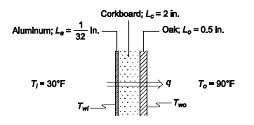Discuss the below:
Q: A composite refrigerator wall is composed of 2 in. of corkboard sandwiched between a?1 in. thick layer of oak and a 1/32 in. thickness of aluminum lining on the inner surface. The average convective heat transfer coefficients at the interior and exterior wall are 2 and 1.5 Btu/(h ft2 °F), respectively.
(a) Draw the thermal circuit.
(b) Calculate the individual resistances of the components of this composite wall and the resistances at the surfaces.
(c) Calculate the overall heat transfer coefficient through the wall.
(d) For an air temperature inside the refrigerator of 30°F and outside of 90°F, calculate the rate of heat transfer per unit area through the wall.
GIVEN
Refrigerator wall: oak, corkboard, and aluminum
Thicknesses
Oak (Lo) = 0.5 in
Corkboard (Lc) = 2 in
Aluminum (La) = 1/32 in
Convective heat transfer coefficients
Interior ( hci ) = 2 Btu/(h ft2 °F)
Exterior ( hco ) = 1.5 Btu/(h ft2 °F)
Air temperature
Inside (Ti) = 30°F and Outside (To) = 90°F
ASSUMPTIONS
One dimensional, steady state heat transfer
Constant thermal conductivities
Contact resistance between the different materials isnegligible
